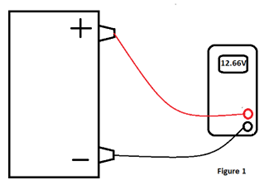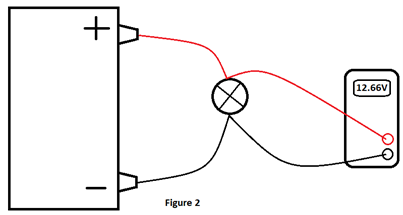By Kevin Roberts
“Voltage Drop” as a phrase has almost become a cliché, a series of words that is commonly used but not always well understood. In this article I will try to get below the surface. Let’s get so familiar with the Voltage Drop principle so that when we see something odd, (like apparently good voltage to a good bulb that doesn’t work, or 12 volts at the chassis frame) our understanding of that principle quickly points us in the right diagnostic direction.
So, what is a Voltage Drop?
To understand this, we need to start with voltage. Voltage is a potential energy level difference between two points. It is not 12 volts at the positive terminal and zero volts at the negative terminal. If an FLA battery is fully charged, there is a 12.66 volt potential energy level difference between the positive and negative terminals. See figure 1.

Once you see this, it becomes clear that you can’t measure voltage with one meter lead. You need two.
Second, voltage can be static. A fully charged battery can maintain voltage for a considerable amount of time.
If you are really sharp, you will pick up on the idea that the difference between the leads can be zero even if both would be above zero in relation to other points in the circuit. For example, if both leads are placed on the positive side of the circuit. (This is important even though you may wonder why I mention it)
Next, you will find that the meter leads can show voltage elsewhere when connected to a very simple circuit. Let’s say you have a battery, a bulb, and two wires, one from the battery positive terminal to the bulb, and one from the battery negative to the bulb. See figure 2.

If you place one meter lead at each terminal of the bulb you find the same voltage as was found at the battery. (Actually, only close to the same voltage for reasons described in a future article)
So, what do we have? A voltage at the battery. A voltage at the bulb. Let’s give them names. Source voltage is at the battery. Available voltage is at the bulb.
I hear you ask how all this refers to Voltage Drops.
The bulb, not being a source of voltage but having a potential energy level difference across its two terminals is (wait for it): A Voltage Drop.
We may not always call it that, but our purpose today is to show that any Load in a complete electrical circuit is a Voltage Drop.
So, now we have two terms, Voltage Drop and Load, that mean the same thing.
Let’s find some more.
In order for a Load to provide a useful Voltage Drop, it must provide a certain amount of electrical resistance, it must resist the flow of electrons. There is our third term: Resistance.
Have you ever connected a wire from battery positive to battery negative? Or a ratchet? Or what used to be a ratchet? Simply connecting a conductor to the battery terminals will provide a complete circuit. But not the kind we usually want.
We need that Load, that Resistance, that Voltage Drop to provide a service. That service is to limit the Current Flow in the circuit to acceptable levels. There is our fourth and final (for now) synonym: A Current Limiter.
If you can get it through your thick skull (Oops, I slipped into talking to myself there for a moment) that a Voltage Drop, a Load, a Resistance, and a Current Limiter all MEAN THE SAME THING, you have joined an informed group of Technicians.
If you go back to Figure 2, you can see that our bulb is a Load, that functions as a Current Limiter, because it has Resistance and that can be measured using Voltage Drop Testing with a meter.
Many Technicians have developed a sense that a Voltage Drop is a bad thing. Not necessarily. All Loads are Voltage Drops. As Technicians, our goal is to verify that every Voltage Drop is an intended Voltage Drop.
Next time: Three Voltages and where we find them.





